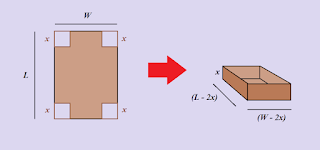Abstract
We study what integer dimensions of a rectangular piece of cardboard provide integer solutions to a standard optimization problem in introductory calculus.
Setup
We have a rectangular piece of cardboard, of length 𝐿 and width 𝑊. Four equal-sized squares of sidelength 𝑥 are cut out of each corner, and the resulting flaps are folded up to produce a box. The quantity to be optimized is the volume 𝑉 of the resulting box.
Objective function & feasible domain
Once the squares are cut out, the dimensions of the base are 𝐿 - 2𝑥 and 𝑊 - 2𝑥, making our volume function
𝑉 = 𝑉(𝑥)
= 𝑥(𝐿 - 2𝑥)(𝑊 - 2𝑥)
= 4𝑥³ - 2𝑥²(𝐿 + 𝑊) + 𝑥𝐿𝑊.
The feasible domain for 𝑥 is
0 ≤ 𝑥 ≤ min(𝐿, 𝑊)/2.
Solution for 𝑥
We differentiate our objective function to find its stationary points:
d𝑉/d𝑥 = 12𝑥² - 4𝑥(𝐿 + 𝑊) + 𝐿𝑊,
and plugging directly into the Quadratic Formula, the stationary points occur at
𝑥 = [4(𝐿 + 𝑊) ± √{16(𝐿 + 𝑊)² - 48𝐿𝑊}]/24
𝑥 = [(𝐿 + 𝑊) ± √{(𝐿 + 𝑊)² - 3𝐿𝑊}]/6
𝑥 = [(𝐿 + 𝑊) ± √{𝐿² - 𝐿𝑊 + 𝑊²}]/6
Notice that the stationary points are homogeneous in 𝐿 and 𝑊, i.e. if we scale the box up by a factor λ, the stationary points
𝑥₋ = [(𝐿 + 𝑊) - √{𝐿² - 𝐿𝑊 + 𝑊²}]/6
𝑥₊ = [(𝐿 + 𝑊) + √{𝐿² - 𝐿𝑊 + 𝑊²}]/6
also scale by a factor λ. Therefore, if some particular values of 𝐿 and 𝑊 give rational but not integral values of 𝑥₋ and 𝑥₊, it's always possible to scale them so that 𝑥₋ and 𝑥₊ become whole numbers.
If L ≠ W, the stationary point x₊ is outside the feasible domain
Although the quadratic formula gives us two distinct stationary points 𝑥₋, 𝑥₊ when 𝐿 ≠ 𝑊, only one of them is feasible in the real-world context. Since √{𝐿² - 𝐿𝑊 + 𝑊²} > min(𝐿, 𝑊), it follows that
𝑥₊ = [(𝐿 + 𝑊) + √{𝐿² - 𝐿𝑊 + 𝑊²}]/6
> [3min(𝐿, 𝑊)]/6 = min(𝐿, 𝑊)/2
is never in the feasible domain, and can be omitted as a possible extremum.
Another way of seeing this: since our objective function 𝑉(𝑥) has zeroes at 𝑥 = 0, 𝑥 = 𝐿/2, and 𝑥 = 𝑊/2, then if 𝐿 ≠ 𝑊, by Rolle's theorem 𝑉(𝑥) must have a horizontal tangent in the open interval between 𝑥 = 𝐿/2 and 𝑥 = 𝑊/2. See Cardboard Box OptimizationVisualizer (desmos.com)
Getting "nice" rational answers
If we hope to get a rational answer for 𝑥₋, we need 𝐿² - 𝐿𝑊 + 𝑊² to be a perfect square. This is equivalent to specifying that we need 𝐿, 𝑊 to be two sides of a 60° triangle which has 3 integer sides, i.e. (𝐿, 𝑊, √{𝐿² - 𝐿𝑊 + 𝑊²}) form an Eisenstein triple. Wikipedia gives the following list of primitive Eisenstein triples for small values of 𝐿 and 𝑊:
|
Length, 𝐿 |
Width, 𝑊 |
√{𝐿² - 𝐿𝑊 + 𝑊²} |
|
3 |
8 |
7 |
|
5 |
8 |
7 |
|
5 |
21 |
19 |
|
7 |
15 |
13 |
|
7 |
40 |
37 |
|
8 |
15 |
13 |
|
9 |
24 |
21 |
Plugging these values into the Quadratic Formula given above, we find the following values for 𝑥₋:
|
Length, 𝐿 |
Width, 𝑊 |
√{𝐿² - 𝐿𝑊 + 𝑊²} |
𝑥₋ |
|
3 |
8 |
7 |
(3+8-7)/6 = 2/3 |
|
5 |
8 |
7 |
(5+8-7)/6 = 1 |
|
5 |
21 |
19 |
(5+21-19)/6 = 7/6 |
|
7 |
15 |
13 |
(7+15-13)/6 =3/2 |
|
7 |
40 |
37 |
(7+40-37)/6 = 5/3 |
|
8 |
15 |
13 |
(8+15-13)/6 = 5/3 |
|
9 |
24 |
21 |
(9+24-21)/6 =2 |


Comments
Post a Comment